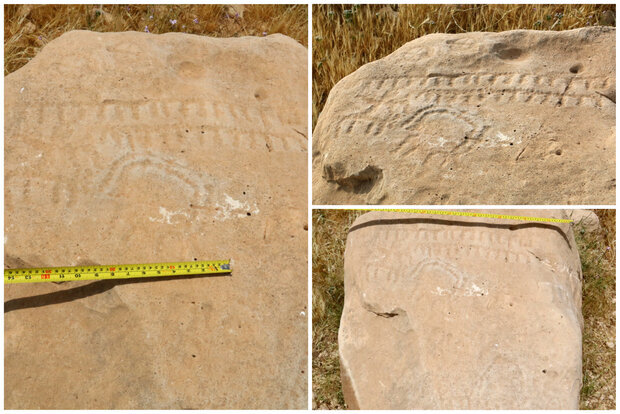Expert hails find of ‘Bronze Age’ petroglyph in southern Iran

TEHRAN – A cultural heritage expert says a petroglyph recently discovered near Davan dates back to the Bronze Age, adding it may provide an extraordinary insight into the prehistoric life across the southern Iranian village.
Discovered in the Kazerun region of Fars province, the petroglyph bears various motifs, drawings, and geometrical shapes.
“Preliminary studies indicate that stone carvings on the object date from the Bronze Age; some 3500 to 5000 years ago,” Mehr quoted cultural heritage expert Mohsen Abbaspour as saying on Monday.
“The discovery, in addition to adding another significant evidence to paleontological studies, has underlined the importance of focusing on such studies in the Kazerun region.”
The expert, however, voiced hope that a research base will soon be established in the Kazerun region to conduct systematic studies on many documents discovered there.
Describing the prehistorical piece of art, Abbaspour said: “The majority of its portrayals are engraved on the upper surface of the object, which measures one and a half meters long, and its widest part is one meter and twenty centimeters.”
“The height of the stone in Its highest section is seventy centimeters. From the traces left on the lateral surfaces of the rock, it is clear that the lower half of the rock has been concealed in the soil for a long time.”
There are two sets of portrayals of the object, he said. “The upper one is purer, and the set that is at the bottom is less legible due to erosion.”
In the upper part, there are two animal motifs, both of which are oriented to the right, and one of them has large branches that continue in a crescent shape to the back of the animal.
The expert suggests some depictions on the prehistorical work of art may refer to the domestication of horses in the southern Iranian region.He noted comparable drawings may provide further insight to help the petroglyph being deciphered.
“Considering the similar drawings in other petroglyphs, it can be assumed that this painting may depict a mountain goat.”
It seems that a human is ridden on one of the animals, which is carved at a short distance from these two other animals and a little higher, two continuous lines can be seen, from each of which small and equal lines extend at relatively regular intervals downwards, Abbaspour explained.
“Above those lines, two circles are seen at a small distance from each other, in each of which two diagonal lines are drawn so that the shape of a plus sign is created in each circle.”
Furthermore, The expert suggests some depictions on the prehistorical work of art may refer to the domestication of horses in the southern Iranian region.
“In the lower part, some pictures are less legible. However, it seems two four-legged animals are depicted there with faces looking rightward.”
Also, two semicircular arches similar to the branches of a four-limbed animal that can be seen in the upper part of the petroglyph, are drawn in this part as well, he added.
Along these arches, a line is drawn that after about 20 cm in length, with an angle close to the vertical, continues to the top of the portrayal and extends about 20 cm, and returns slightly inward again, Abbaspour said.
Comparing the object with other similar historical monuments, he noted: “Considering the elements used in this petroglyph and comparing it with other similar ones discovered in Kazerun, as well as comparative studies on petroglyphs discovered on the plateau of Iran, the newly-discovered petroglyph dates back to the Bronze Age; a time between 500 BC to 3,000 BC.
“Since horses were domesticated around 3,000 BC, the petroglyph could not be more than 5,000 years old.”
“One of the striking features of this painting, which makes it more prominent than some other similar works, is the presence of abstract images on it, especially in its upper part, where we see two continuous lines, small lines of which are drawn downwards,” he stated.
Also, on the upper part of the aforementioned lines, we see two circles that are similar examples of which have been seen on petroglyphs discovered both on the plateau of Iran and in several other parts of the world, for example in Kenya, he said.
“Until the exact function of all the elements used in this painting is determined, we may consider it depicting a kind of ritual or a common way of life of the people in the plain of Kazerun during the Bronze Age.”
The Kazerun region is one of the most important areas in the field of archaeological and prehistoric studies for various geographical and historical reasons, and to date, based on the results of studies on the remains of human habitation in this region, it can be said that the human presence in Kazerun dates back to the Neolithic period, that is, about 30,000 to 40,000 years ago, the expert concluded.
The Islamic Republic plans to put forward clusters of its millennia-old petroglyphs as a candidate for inclusion in UNESCO’S World Heritage list, according to the tourism office of Khomein that its Teymareh region is home to numerous petroglyphs.
In March 2020, a team of entomologists and archaeologists concluded one of Teymareh petroglyphs showcases a six-limbed creature with the head and arms of a praying mantis. The rare 14-centimeter rock carving was first spotted in the Teymareh rock art site during surveys between 2017 and 2018, but could not be identified due to its unusual shape.
According to a survey by the international experts Jan Brouwer and Gus van Veen, rock art was made 40,000-4,000 years ago.
Experts believe prehistoric rock arts provide insights into past eras and cultures as archaeologists classify the tools for the carvings by specific eras Incising tools include flint, metal, or thigh bones of hunted prey.
AFM
